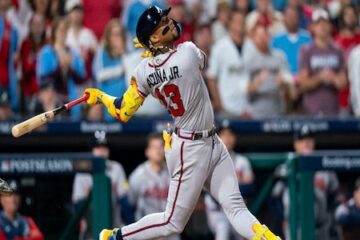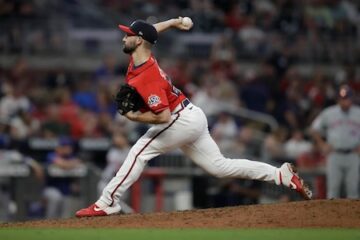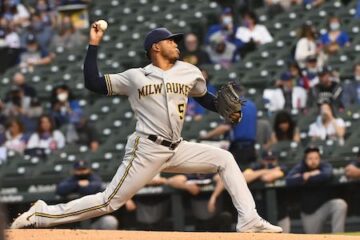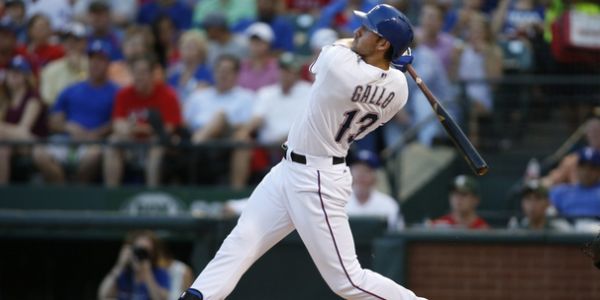2015 Fantasy Baseball: Staff Rankings Roundtable Discussion

I think it’s a good practice, regardless of the application, to try and improve yourself and learn something new every single day. It’s difficult to learn when you think you know it all.
With that very thought in mind, I work with a lot of really bright baseball minds here at TheFantasyFix. It’s pretty cool, actually. I felt compelled to pick the brains of my colleagues and fellow FantasyPros rankers to better understand their point of view on a few players that seem to be outliers for them. They were kind enough to answer, and Brett tossed the ball back in my court at the end of the post. You can find our positional rankings here, and we would love to hear from readers in the comment section.
As any intelligent person would, I started at the top.
Alan Harrison
Q: Alan, you and I are on the same page with regard to Todd Frazier. He’s not in your top 10 at third base, so I’m guessing that you don’t expect Frazier to repeat his 29/20 from last year. What are your expectations this season?
A: Frazier has been a fine real and fake baseball player for the past handful of years, but last year’s age-28 season effort was clearly a career year. Prior to last season’s 29 homers, Frazier had never eclipsed the 20 home run plateau; he tacked on an extra 10 in ’14 likely due to a spike in HR/FB% to 17%, also a career best with a minimum of 50 ABs in a single season. And prior to ’14, Frazier’s career best stolen base mark was six in 2013, yet he swiped 20 last season? I think folks are on the right track by targeting Frazier — he’s a nice value at the hot corner and may just reach double digit homers and steals again in ’15 — but I think they’re paying a hefty premium for last season’s production, a price I’m not willing to pay.
Q: You aren’t buying on a repeat from Josh Harrison either? Only room for one Harrison here or is it something else?
A: He’s a Harrison, I’ll always make room for more. And to be honest, I believe I failed at ranking him appropriately due to his multiple position eligibility. For me, he’ll probably be a top 12-15 guy at worst in both the second and third base rankings. Harrison’s batting average, power and speed contributions impressed (and surprised) us in ’14, but I’m not sure his .314 batting average is sustainable due to his crazy high .353 average on balls in play. I like Steamer’s .278 with 12 homers and 17 swipes projection, but I may even drop the homers down to 10. He’s on my list of targets in leagues with daily roster moves thanks to his multiple position eligibility.
Q: Sell me on the Kevin Gausman breakout that’s coming. Our site consensus has him as the 69th best starting pitcher, but he cracks your top 50, coming in at 46.
A: Maybe 46th among starting pitchers was a bit bullish on my end, but I believe those middle tiers of starting pitchers are larger and he has some of the offerings in places to make a significant jump in ’15. The Orioles’ starter shows great velocity on his fastball that sits around 95 mph, a fair changeup that comes in at 85 mph — a nice 10 mph difference between that and his fastball — and a splitter that dives into the plate at about 83 mph. The splitter is filthy, inducing whiffs about 23% of the time and holds opposing batters to an .087 ISO against it.
Gausman’s strikeout and walk rates both trended slightly in the wrong direction last season, but they weren’t too far off his career rates or league averages for starters. The former first round pick has the pedigree and most of the tools to be a top-50 fantasy pitcher, and I think 2015 is the year in which he makes it happen.
Gerard Martin
Q: Gerard, Matt Shoemaker comes in as the 48th starting pitcher in our site rankings, but you have him 20 spots higher at 28. Is Shoemaker the Love Child of Javier Baez and Manny Machado, or is he just the pitching version of this man-crush trio?
A: I’m a sucker for a great K/BB ratio, and Shoemaker was among the best in baseball in that department last season, with a 5.17 mark that ranked 12th among pitchers who tossed at least 130 innings, sandwiched between Corey Kluber and Madison Bumgarner. Excellence in that stat indicates an ability to command bat-missing stuff within the strike zone. An ability to find a strikeout when the situation demands it, but also limit the occurrence of those kinds of situations. For me, that’s what makes a great starting pitcher.
Shoemaker doesn’t have an overwhelming fastball, but his complete arsenal is more than enough to keep hitters off balance. His splitter is dominant against hitters from both sides of the plate; it’s among the best in baseball at both generating swings and at ensuring that those swings come up empty. When he does allow contact, Shoemaker allows hitters to put the ball in the air quite a bit, but in Anaheim, that’s not much of an issue.
Shoemaker did get a little bit BABIP lucky last season, but he still finished the year with a 3.28 xFIP. I’m not sure why I should expect anything less this year. A quick glance over his Triple-A ERAs makes that statement seem ridiculous, but I think Shoemaker was just a horrible fit for the PCL. Jered Weaver has proven that you can be successful as a crafty fly ball pitcher in LA, and I expect Shoemaker to follow a similar blueprint to success this season.
Q: I’m worried about you. I thought your love for Chris Davis was a bit much, but then I saw you have Eric Hosmer ranked ahead of him (11th among first baseman.) Tell us why THIS is the year Hosmer finally puts it all together.
A: I’m going to try really hard not to use the word “momentum” here, but I’m really encouraged by what Hosmer did in the playoffs last season, ripping off a .351/.439/.544 line over 66 postseason plate appearances. There’s certainly some favorable BABIP luck in there, but I feel like Hosmer grew into a more confident player during that playoff run. The power is really what gets me excited. We know he’ll run, and we can reasonably expect a decent batting average; if he brings some pop to the table, he’s Paul Goldschmidt-lite. And I think he can.
Hosmer was actually better than his nine home runs would indicate during the regular season; his overall flyball distance was sandwiched in between Kyle Seager and Albert Pujols, both of whom managed better than 25 homers last season, despite playing in less than ideal home situations. Hosmer doesn’t hit the ball in the air as often as those guys, but he picked up his FB% in September, while still maintaining a 12% HR/FB rate. If he can do that over a full season, that’s a 20-homer level of production. That might be too much to ask, but even 18 bombs, 10 steals, and a batting average around .280 is more than enough to land him on the fringes of the top ten.
The talent has always been there, Hosmer’s just never put his entire skill-set together in one season. I think something clicked for him during the postseason; this is the year he does it.
Q: At times it’s difficult to fade the spring training buzz, but you seem to be doing that with Matt Harvey. Harvey has looked strong in his two spring starts to date, tell us why you’re hesitant to invest on draft day.
A: It has nothing to do with production, just the fact that Harvey has more risk associated with him than the average pitcher. I don’t doubt that he’ll have a good season, I’m just not willing to pay the price to take on that extra level of risk. I’d rather let somebody else take Harvey and jump on a safer choice like Jeff Samardzija or James Shields.
Brett Talley
Q: You aren’t willing to pay the price it’ll cost to land you Harper, but it looks like you’re willing to roll the dice later in the draft and grab Joc Pederson a round or two ahead of where he falls in our site rankings. You have him as your 45th OF. What do you expect from Pederson this season?
A: Instead of telling you what I expect from Pederson, let me explain why I have him ranked like I do. I’m most definitely a “wait on pitching” guy and usually fill out my hitter slots before anyone else in a draft. For that reason, the odds are good that I’m going to have filled all of my outfield spots by the time a draft is half over. So if I’m taking an outfielder late in a draft, I’m not really looking for someone I can rely on. I’m just looking for upside to stash on my bench, and Pederson has it.
I don’t necessarily have a strong feeling about him reaching his upside or not, but I know his ceiling is going to give me more than some safer guys going around him like Denard Span or A.J. Pollock. If you’re looking for a fifth outfielder and not a bench bat, I can see why you might go with Span or Pollock. But guys like that have little chance of displacing an outfielder I drafted earlier while Pederson might have that upside.
Q: Be honest Brett, your Justin Verlander hate is more about seeing his naked behind in that Kate Upton picture than it is about his ability to pitch still, right? He failed to crack your top 60 starters. You’re obviously not buying a bounce back.
A: Absolutely not. About the only thing I still like about Verlander is his relationship with Upton bringing her name across my baseball-heavy Twitter feed more often. But from a baseball perspective I can’t get past his significantly reduced ability to miss bats last year. His swinging strike rate fell almost two percentage points, which took a huge chunk out of his strikeout rate. The hit was so big that his K-BB% was below average last year.
I don’t have a stated philosophy of not drafting pitchers with a net strikeout rate that is below average, but that’s only because players without at least average strikeout and walk skills rarely cross my radar. I’d much rather draft guys with an above average K-BB% that are going after Verlander like…well, actually that would be a very long list of players given Verlander’s ADP in the top 40 among starters. I’ll just say there are A LOT of guys who displayed better skills last year that are going after Verlander.
Q: I’m not sure I’ve seen Jose Abreu atop anyone’s first base rankings this season…until now. He’s the top option at first in your rankings. Are you expecting him to improve on last years numbers, or would he still be the top option solely by repeating last season’s incredible debut?
A: By my calculation, the only first baseman that outperformed Abreu last year was Victor Martinez, who no longer qualifies at first base. So it’s my contention that Abreu is the reigning fantasy first base champ. He’s got the belt in my mind. And the candidates to take it from him both have little injury things I’m worried about. Miguel Cabrera is obviously dealing with injuries already, and I wonder if he won’t continue to deal with them once he gets over this ankle issue, assuming that it doesn’t linger. Paul Goldschmidt‘s 2014 season ended with a broken hand, and hand injuries have been known to sap some power. Plus, Goldy was only on pace for 28 home runs before his injury last year.
I also think people are hesitant to give Abreu the top ranking because he’s due for some regression in BABIP and home run rate. But his expected BABIP and expected home run rate last year were not that far below his actual rates. Any regression should be slight. He’s not going to give the belt away. Someone is going to have to take it, and the challengers look hampered.
Gerard and Brett
Q: After an up and down start to his career, there are essentially two sides of the Bryce Harper coin nowadays: the Show Me side and the Unlimited Potential side. Gerard, ranking him inside your top 10 at the position feels like you’re on the Unlimited Potential side, while Brett has him outside of his top 20 outfields and the site consensus has him at 12.
Gerard: The one time that Harper played a full season, he swatted 22 homers, swiped 18 bags, and slashed .270/.344/.477. And at the beginning of that season, he wasn’t even old enough to enjoy a champagne toast in celebration of his call-up. Entering his fourth season with the Nationals, Harper is still ten months younger than Kris Byrant!
He plays with reckless abandon and though the resulting injuries have sapped his production in recent seasons, it hasn’t just been because of games missed; Harper has played much of the last two seasons at less than full strength. That doesn’t just hurt his production in those seasons, it also sets an artificially low baseline for his projections, which generally see Harper topping out at around 25-ish homers in 2015. I’m not buying it. If healthy, he’s got as good a chance as any outfielder to crank 30 home runs. There’s certainly risk that he won’t make it through 600 healthy plate appearances, but I’ll pay for Harper’s potential.
Brett: If Harper gets 600 plate appearances, I’m going to be too low on him. But I sort of feel about Harper like I feel about a mobile quarterback like Robert Griffin III or even Michael Vick. They’re immensely talented with a ton of upside, but their style of play lends itself to some injuries. We’ve seen that from Harper with him literally running full speed into a wall. I think he’ll be productive enough when he’s in the lineup, I just think he may not be in the lineup to get to 25 home runs.
The one thing production-wise I’m worried about are the contact problems he had last year. The 72.7% contact rate was well below the 76-77% range he was in prior to last year. It should have hurt his average but didn’t because he posted a .352 BABIP. But if the BABIP doesn’t hold and the contact problems persist, his batting average is going to be a problem.
Ryan Noonan
Q from Brett: I’d like to know why Gerard isn’t on the Carrasco bandwagon, but please explain why you like him as a top 30 starter?
A: I might be too low on Carlos Carrasco to be quite honest. As the advancements in DIPS (defense independent pitching statistics) continue, it’s becoming easier to gauge elite pitching in my opinion. Thank God so many smart people love baseball. My pitching evaluations and rankings are being driven from three key metrics this season: Jonathan Judge’s work with ‘cFIP,’ hard-hit data from Mark Simon and his team at ESPN stats, and the simple yet effective K-BB/IP driven my Michael Salfino. All three of these measures cast Carrasco as elite. His 78 cFIP last season was the same as Stephen Strasburg. Batters failed to square him up well, too, as his hard-hit info has him in the top-10 last season, same as his K-BB/IP totals. Check. Check. Check.
Q: While you’re at it, tell Alan and Gerard why they’re way too low on Mike Fiers.
A: Let’s stay on topic here. Fiers didn’t throw enough innings last year (only 71 2/3) to register on the hard-hit chart, but he’s nearly identical to Carrasco in cFIP (80) and K-BB/IP (both are at 0.82 with league average being 0.51). I trust Carrasco more due to his ability to enduce more ground balls, but I’m willing to take a risk on Fiers despite his limited innings last season. His ECR at FantasyPros is SP49, but Fiers is hovering around SP30 for me.
Q: Third base is considered by many to be a thin position this year, but you have Josh Donaldson and Nolan Arenado ranked pretty highly overall. Is this a result of concerns about positional scarcity or more just that you like what these guys have to offer from a production standpoint?
A: It’s a combination of both. I really like these two players specifically, and the position as a whole is in flux. It’s still relatively deep, but the old guard is being replaced at the top but younger players in great hitting environments, and that’s what we have here.
What’s not to love about Josh Donaldson? He hit 29 home runs last season while playing half of his games in one of the worst hitting parks in baseball, and he’s moving to perhaps one of the friendliest. He’s likely to hit either second or fifth in the Blue Jays lineup, so he’ll either be scoring 110 runs or knocking in 110 runs. I can’t imagine him hitting less than 30 home runs if he gets 650 plate appearances.
My man crush on Nolan Arenado is strong, I know. Clearly, there’s no place a hitter would rather call home than Coors Field. He has consistently shown the ability to hit for high average, supported by a better than average line drive rate and incremental improvements in power. He nearly hit 20 home runs in just 111 games last season, and he was a doubles machine (34). His improved walk rate in the second half is an encouraging sign here, too. I’m all in.





